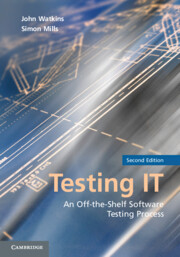Book contents
- Frontmatter
- Contents
- Foreword to the Second Edition by Geoff Thompson
- Foreword to the First Edition by Maurice Rosenburgh
- Acknowledgments
- 1 Introduction
- PART 1 THE TRADITIONAL TESTING PROCESS
- 2 An Overview of Testing
- 3 Testing Techniques
- 4 The Management and Planning of Testing
- 5 Unit Testing
- 6 Integration Testing
- 7 System Testing
- 8 Systems Integration Testing
- 9 User Acceptance Testing
- 10 Operations Acceptance Testing
- 11 Regression Testing
- 12 Improving the Testing Process
- 13 Introduction, Adoption, and Maintenance of the Testing Process
- 14 Agile Testing
- PART 2 THE TESTING PROCESS IN THE REAL WORLD: ILLUSTRATIVE CASE STUDIES
- PART 3 THE APPENDICES
- References
- Glossary
- Index
14 - Agile Testing
Published online by Cambridge University Press: 03 May 2011
- Frontmatter
- Contents
- Foreword to the Second Edition by Geoff Thompson
- Foreword to the First Edition by Maurice Rosenburgh
- Acknowledgments
- 1 Introduction
- PART 1 THE TRADITIONAL TESTING PROCESS
- 2 An Overview of Testing
- 3 Testing Techniques
- 4 The Management and Planning of Testing
- 5 Unit Testing
- 6 Integration Testing
- 7 System Testing
- 8 Systems Integration Testing
- 9 User Acceptance Testing
- 10 Operations Acceptance Testing
- 11 Regression Testing
- 12 Improving the Testing Process
- 13 Introduction, Adoption, and Maintenance of the Testing Process
- 14 Agile Testing
- PART 2 THE TESTING PROCESS IN THE REAL WORLD: ILLUSTRATIVE CASE STUDIES
- PART 3 THE APPENDICES
- References
- Glossary
- Index
Summary
“Agile is arguably a thirty year old overnight success.”
– Bob BartletIntroduction
This chapter discusses the “recent” phenomenon of agile approaches to software development and testing, reviews a number of successful agile quality management practices being employed by testing practitioners on real-world projects, and concludes by making a series of recommendations about how to implement an effective and efficient agile testing approach.
Chapter 20 provides a case study that documents the role and use of agile testing best practices within the context of an agile development and testing project.
Overview of Agile Testing
In recent years new approaches to the development and testing of software and the management of software projects, such as Extreme Programming (XP) and Scrum (50 and 51) have encouraged practitioners to be more agile in the delivery of software systems.
The typical features of such agile approaches include:
Breaking large monolithic software projects down into smaller more easily achieved iterations
The rapid delivery of working elements of the developing system for early testing and to gain feedback from the customer on the suitability of the software
Colocation of the development and testing team with suitably knowledgeable and empowered customer representatives
Employing use cases (8) or user stories (50) to capture customer requirements in a clear and simple manner that enables the customer to understand and agree on the requirements
Being as responsive to customer requests for changes to the developing system as possible
Employing focused and effective project communications including stand-up meetings (51), agile retrospectives (53), and short lines of communications
[…]
- Type
- Chapter
- Information
- Testing ITAn Off-the-Shelf Software Testing Process, pp. 117 - 124Publisher: Cambridge University PressPrint publication year: 2010



